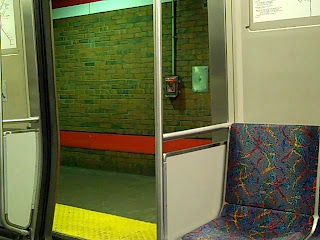 |
"Lovin' It!"
Photo: Angela M. Counts |
This week, coming back from Spring Break -- I feel myself as if still in a dream or some would say a nightmare. Somnolent walking. The after effects of the quake continue as we all know, and there are so many problems in all corners of the globe. At the same time, here in Boston, we awake from a long winter to smell the crocuses and to watch the sun set late in the evening in the west. There is a feeling of thawing, if not hope. To describe how I feel, it takes metaphor. And that's what language is... and often that's what the city feels like. We rub up against its realities, but if we take a step we can also appreciate its poetry.
 |
"Boston Red Dogs in the Common"
Photo: Angela M. Counts |
S
treet. Streets in Boston follow cow paths. At least that's what I was told when I moved here many years ago and found myself lost in a maze of cobblestones. This of course only in the historic parts of the city. But this is too literal perhaps. What about one's state of mind about the streets, whether paths are circular, circuitous, or if one street like Tremont intersects with itself in downtown Boston. What about the person who makes their living on the streets? And I'm not talking about the world's oldest profession, but perhaps the second oldest -- the street vendor. Do maps of the city also map our consciousness, just as much as they point the way to the place where we can grab a salty but delicious meal for cheap, or stop for a moment to delight in musical stylings of the kooky street musician?
 |
"One-Man Band"
Photo: Angela M. Counts |
Ch
ange my mind. That's what advertisers strive to do. On billboards, in storefront windows; on the side of tractor trailers. As an example, McDonald's has sold (trillions?) of hamburgers around the world. These days, it may be a no-no to openly admit eating there, especially after
"Super Size Me" the movie, but nonetheless there are billions of people on the planet who apparently proclaim in English "I'm Lovin' It" according to Mickey D's. That's what the sign on the side of the tractor-trailer next to my car said. Who am I to argue with the colloquialism or the confession?
 |
"Rental"
Photo: Angela M. Counts |
Z
oo. No not the kind that houses (or some would say imprison) animals. Kids love zoos. I do too, when I shut off the part of my brain that worries about incarcerating wild animals. But no, I'm not talking about that; although there is an incredible zoo right tin the city of Boston called
Franklin Park Zoo. But the type of Zoo I'm talking about is the big business of apartment rentals in the city. It's a realtor's market -- what with the students, medical residents, business people, immigrants and more arriving each month in the city of Boston and its outlying areas. Where are they all to live, and which neighborhood will catch their fancy? Well if you're ingenious enough of a realtor you'll put a mannequin in the window of your storefront, with a T-shirt that says "Rental." As an art student I couldn't help but think that the realtor must be an art school dropout or MFA grad who's doing installation art while trying to make a buck.
I'm lovin' it! By the way, that's a McDonald's trademark so be careful how you appropriate it.


































